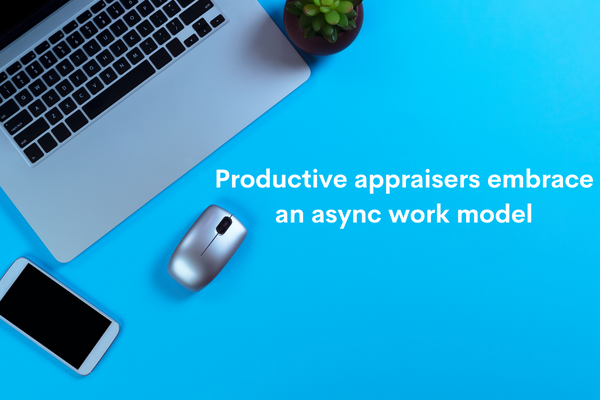Many appraisal managers and appraisal firm owners’ careers might be damaged by staying with the same leadership playbook. It’s a mistake to think you can succeed by hanging on to a traditional office model expecting them to work in a remote form.
The problem? Many appraisers are like outsourced Upwork labor, working remote but distant. Bank appraisers out of site for C-suite, zapping influence. Fee appraisers with diminishing collaboration, psychological safety and social interactions.
The result? Long-term it’s not sustainable.
Lead through unmanagement
It was insightful to be on a Zoom session with Liam Martin author of Running Remote: Master the Lessons from the World’s Most Successful Remote-Work Pioneers. One big take away is async leadership of unmanagement. He believes embracing an async work model is going to be mandatory to stay competitive.
“Leadership will be agnostic towards anything but results.”
I think this requires not thinking like an appraiser otherwise you might have what the author calls Remote Force. This means too many scheduled lengthy Zoom meetings. Formats that don’t vary or change with any frequency, generic activities that seem obligatory and faux culture building.
There are three models: 1. everybody stays at home forever 2. some people have to sometimes report to the office (hybrid) or 3. everyone has to come to the office. As the leader, it’s your choice, but choose wisely.
Look up from your HP12c
Successful remote work requires asynchronous/autonomous mindset which means having the ability to focus on outputs. Remote achieves “beast mode” productivity with deliberate purposeful communication. Intrinsic in the model is that remote work must have a strong but flexible process, not only delineates workflow, but keeps all lines of communication open. It’s critical that the communication explicitly conveys company values often.
Revisit your motivations
Culture should be defined by WHY you work together. Why does the work you do matter? Does the work you do at your appraisal department or appraisal firm change the world?
As an appraisal manager or firm owner, you can decide to kick the can to the end of your career or get excited about a fun/more productive/rewarding way to work.
And the numbers…
- 77% of remote employees say they’re more productive
- 80% of remote workers experience less stress
- Remote first companies are 22% cheaper to operate then on premises
- 25% of remote employees will take a 10% pay cut to work remotely
- fully remote companies have 25% lower employee churn
Break-out of bubble work
Believing that our industry is not changing may hasten your retirement. The concept of working remotely seems fairly normal for appraisers since we often work in our own bubble, self-sufficient. But how does our remote business model impact traditional management and work processes?
The author defines the concept as asynchronous management. Leading individuals or teams without simultaneous or asynchronous communication. All information is funneled through online systems to create collaboration. Work focuses on individual autonomy which removes the dependency of team members to complete a task.
Entrepreneurial appraisers, yes that’s a thing
Some of the grounding of this concept is the EOS model (entrepreneurial operating system) which includes six key components. These include data (measurable scorecard), process (documented and followed by everyone), traction (rocks and meeting pulse), issues (broken processes or customer/employee complaints), people (right people in the right seat) and vision (shared by all.)
Still not convinced? A survey of 2,300 full-time American Workers by Owl Labs concluded that 46% of workers would be a lot less willing to go the extra mile if they were no longer allowed remote or hybrid work options. Also 39% would walk out the door and just quit if the ability to work from home was taken away.
Reframing your mindset as a valuation professional can significantly improve your productivity and love of your valuation art. Embrace and leverage the new work model. Take the leap.

